Hull Street Tramways
History
Hull Local Board was first approached with a scheme to build a horse tramway within the town in late 1871. By April 1872, the scheme, which was supported by the council, was in the hands of the Continental and General Tramway Company, a London-based entity, which on the 6th August 1872 obtained powers to build around 7 miles of horse-drawn tramway. The powers were granted under the Hull Tramways Order, which was passed into law under the umbrella of the Tramways Orders Confirmation Act, 1872.
Progress in building the tramway was slow, construction only commencing in August 1873 on the Beverley Road line, which was just within the 1-year time frame permitted by the enabling act. Services commenced along the route on the 5th January 1874 using just two horse cars, though more were on the way. It was by now becoming clear the the CGTCo was not adequately financed, such that it was unable to proceed with construction of the remaining lines, nor it would seem to pay its bills, as it was the subject to a winding-up petition by one of its contractors on the 12th November 1874. At the same time, the company were giving notice of their intention to submit a bill to parliament to create a new company – the Hull Street Tramways Company – to which they would then sell the existing tramway and its powers, as well as its intention to seek powers for additional lines. The new powers were granted, and the company was duly incorporated on the 19th July 1875 under the Hull Street Tramways Act, 1875, the aforementioned assets eventually passing to the HSTCo on the 1st November 1876.
Progress was, however, still slow, the CGTCo somehow finding the money to begin work on the Spring Bank and Old Town lines in 1876, before finally handing over the Beverley line to the HSTCo at the end of October. Matters at last took a turn for the better, the Spring Bank line out to Botanic Gardens opening on the 12th December 1876, the Old Town, Hessle Road, Anlaby Road and Holderness Road lines opening on the 12th March, the 7th April, the 9th June and the 7th July 1877, respectively. This work completed all the lines authorised by the 1872 order. The lines, however, had been built on the cheap, not only having been poorly laid, but also largely on the single line and loop principle rather than as double tracks, a decision that was to seriously constrain the tramway's operational flexibility.
Meanwhile, the CGTCo acquired powers to build further lines, all being short extensions to the existing HSTCo-owned lines; these powers were granted on the 23rd July 1877 by the Hull Street Tramways (Extensions) Order, which was passed into law by the Tramways Orders Confirmation Act, 1877.
Business was initially good, a 4.5% dividend being declared by the HSTCo in September 1877, the extensions (built by the CGTCo and then sold to the HSTCo) opening on the 29th March 1878. These took the standard-gauge horse tramway to its final size of 10.81 miles. From the Wilberforce monument, which at that time was located on Whitefriargate, lines radiated: southwestwards along Hessle Road to Dairycoates; westwards along Anlaby Road to Wheeler Street; northwards along Spring Bank to Botanic Gardens, and along Beverley Road to Newland; northeastwards along Holderness Road to Milehouse; and eastwards along Whitefriargate then southwards via Market Place and Queen Street to Victoria Pier. Although the tracks of the HSTCo and the Drypool and Marfleet Steam Tramways Company virtually met at North Bridge in Witham (on the Holderness Road line), they were never connected.
The new extensions were formally transferred from the CGTCo to the HSTCo on the 27th May 1878 by the Hull Street Tramways Act, 1878, the CGTCo being wound up in March 1879.
The HSTCo now settled down to a few prosperous years of operation, though there were signs of things to come, with increasing competition from horse buses, rising costs, and a poor relationship with the local authority (and the travelling public) over the state of the track, its treatment of its horses, and also of its staff. The tramcar fleet reached its maximum size of 31 vehicles in 1882, though not all were available at any one time.
By 1889, the HSTCo was in trouble, making a loss of nearly £2,500 and facing major expenditure for track renewal. Matters reached a head in November 1889 with a petition to wind up the company, a liquidator being appointed on the 16th January 1890. The liquidator then ran the tramway in an attempt to pay the creditors off, not unnaturally constraining costs as much as possible, a position which hardly endeared him to the corporation. In May 1891, the liquidator reached a provisional agreement to sell the Holderness line to the neighbouring steam tramway (the D&MSTCo), offering the rest of the system, all of which was in badly run-down condition, to the council the following October.
In December 1891, a new company, also called the Hull Street Tramways Company, was set up with the aim of persuading the council to take over and rebuild the tramway, and then to lease its operation to the new company. These proposals ultimately failed, as did the sale of the Holderness line to the D&MSTCo (itself an impecunious affair), the horse tramway meanwhile having to limp on, in poor condition and making continual losses. On top of this loomed the spectre of compulsory purchase, the corporation being entitled to purchase the tramway 21 years after the enabling act (under the Tramways Act of 1870), the initial tranche of lines falling due on the 6th August 1893, all of which meant that no company in its right mind would invest in the tramway without agreement from the local authority to either defer purchase, or to purchase and then lease.
In August 1894, with no agreement having been reached, the Liquidator received authorisation to sell the undertaking to the highest bidder, though there turned out to be only one bid, and for reasons now unknown, it was not proceeded with. On the 23rd November 1894, the Receiver once again offered the system to the corporation and after much haggling, a price was finally agreed on the 1st August 1895.
The corporation now set about planning its new tramway system, which it intended to be worked electrically, though it had yet to decide whether it would operate the system itself or lease it to a company. Powers to take-over the existing horse tramway, convert it to whatever mode of traction it saw fit, and to build a series of additional lines was granted on the 26th July 1896 under the Hull Corporation Tramways Order, which was passed into law under the umbrella of the Tramways Orders Confirmation (No. 1) Act, 1896.
The corporation formally took over the horse tramway on the 15th October 1896, leasing its operation to a local cab proprietor, a Mr W. Nettleton. The first rail of the new electric system was ceremonially laid on the 9th June 1898, the first electric services commencing on the 5th July 1899. Mr Nettleton continued to operate the remaining horse services until the last one was withdrawn on the 30th September 1899, though some sources state that this was actually in November.
Uniforms
In common with many horse tramways in the UK, drivers and conductors wore informal but smart attire — trousers, overcoats, jackets, waistcoats, shirts and ties. Headgear appears to have largely followed the fashion of the day, predominantly the bowler hat, though in later years, flat caps would increasingly make an appearance. No company insignia were worn on either the jackets or the hats, though photographs and documentary evidence indicate that council licence badges were worn in the early years (see below).
Further reading
For more information on Hull's tramways, see: 'A History of Kingston Upon Hull's Tramways' by Malcolm Wells; Adam Gordon Publishing (2012).
Images
Drivers and conductors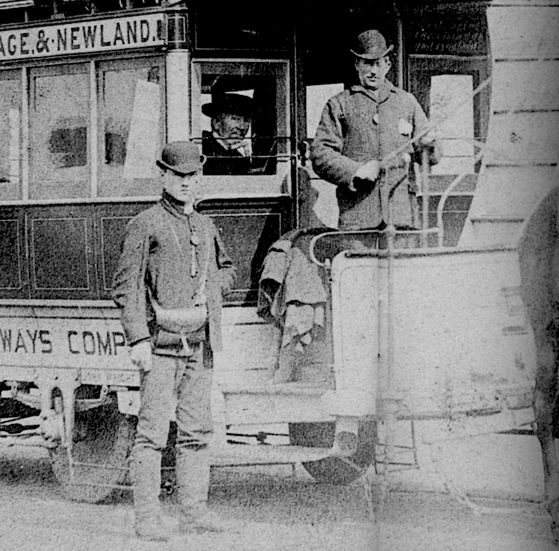
The crew of Horsecar No 3, working the Beverley Road route, pose for the camera — photo undated, but given the attire, probably taken in the late 1870s or early 1880s. Both men are wearing small round licence badges. Photo courtesy of the Tramways and Light Railway Society, with thanks to David Voice.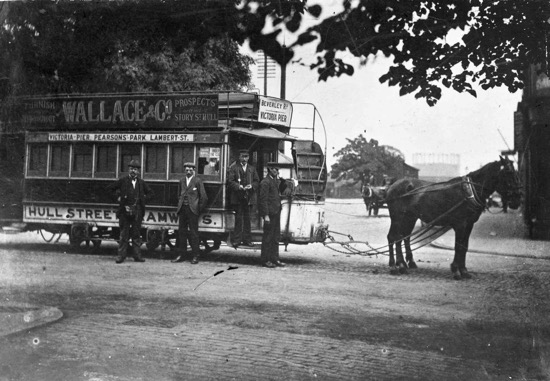
The crew of Horsecar No 15 at Lambert Street with a Beverley Road service bound for Victoria Pier — photo taken in 1895. Photo courtesy of the National Tramway Museum.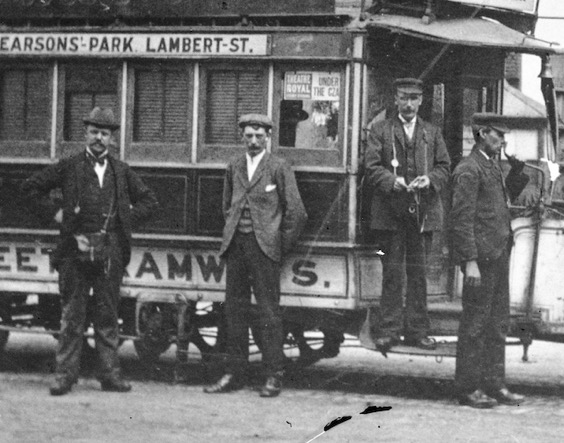
An enlargement of the above photograph showing what are probably two horsecar crews. The figure on the left with a cash bag is definitely a conductor, and the two men on the right are very probably drivers. Whilst the latter look to be wearing uniforms, these are in all probability just informal jackets with the type of soft-topped cap favoured by workers in large ports. The driver on the tramcar steps appears to be wearing a round licence badge.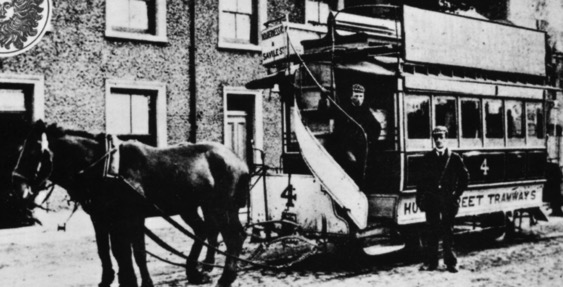
The crew of Horsecar No 4 pose for the camera, possibly in Temple Street — photo undated, but probably taken in the late 1890s. Photo courtesy of the Tramways and Light Railway Society, with thanks to David Voice.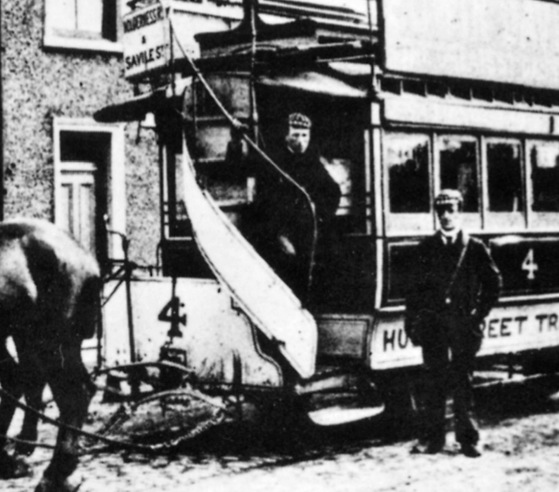
An enlargement of the above photograph showing the driver and the conductor. Both men are wearing informal attire and what appear to be tartan or chequered flat caps.
A photograph of Hull's last horse tram (with black flag affixed), No 23, entering the Temple Street depot — photo probably taken on the last day of September 1899 when the service was operated by W. Nettleton. Photo courtesy of the Tramways and Light Railway Society, with thanks to David Voice.